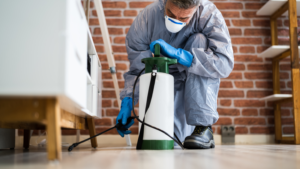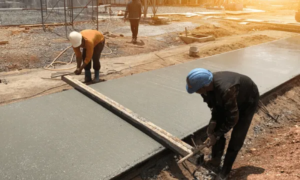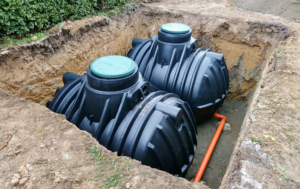Pests are more than just unwelcome visitors. They can carry germs that cause disease and damage property. Contact Bakersfield Pest Control now!
Control measures include prevention, suppression, and eradication. Preventing pests requires understanding their life cycles and needs, including food, water, and shelter. For example, raccoons can get into houses and damage property while eating garbage, pet food, and fish from garden ponds. Preventing them requires making these sources inaccessible and removing trash regularly.

A pest control strategy is most effective when prevention is the goal. Prevention strategies include removing food, water, and shelter sources (depending on the pest), maintaining proper sanitation, and closing off places where pests can enter buildings. For example, putting out trash containers with tight-fitting lids prevents pests from accessing the contents. Eliminating stacks of paper, cardboard, and wood scraps keeps pests from hiding in them. Caulking cracks and crevices and using steel wool to fill spaces around pipes reduces the entry of pests. Keeping garbage receptacles closed and emptied regularly keeps rodents from chewing through needed materials to build nests or get to discarded food.
Scouting and monitoring are also important preventive measures. This involves regular searching for and identifying pests, assessing numbers and damage, and determining the best course of action. Threshold-based decision-making focuses on the ability to identify pest populations at their lowest levels and taking action when a population starts to grow out of control. For example, noticing a few wasps hovering near a picnic table may not warrant intervention, but seeing them every day and in increasing numbers probably does.
Observing and understanding a pest’s life cycle, behavior, and preferred environment helps to predict when and how the pest will become a problem. This information can help you develop control tactics that are targeted at the specific pest’s sensitivity and impact to humans, property, or production.
Physical and cultural control methods can be used in conjunction with scouting and monitoring to keep pest populations below the threshold where they cause unacceptable damage. Trap crops such as zinnia can attract Japanese beetles, which are then easily killed with a spray of insecticide. Changes to soil conditions, such as adding compost, can also alter the environment and suppress pest growth, particularly root diseases and weeds.
Many pests can be prevented with the use of chemical controls. These can be used with little risk if applied according to the label and are kept out of reach of people and pets. Chemicals can be applied by hand, with traps and barriers, or with machines such as pheromone lures and nets.
Suppression
A primary goal of pest control is to suppress or prevent the buildup of damaging populations to intolerable levels. This is accomplished by reducing the number of pests through monitoring and intervention at low numbers before damage becomes apparent. Successful prevention requires a thorough understanding of the life cycle of a pest and its interaction with host plants. This type of management is most successful against regular pests such as greenhouse whitefly and aphids in ornamental plants, but it can also be used on weeds and other vegetable species.
Traditionally, suppression has been achieved by applying insecticides. Increasingly, though, managers are turning to non-chemical methods of pest control in order to reduce the dependence on costly and hazardous chemicals. Non-chemical controls may include manual removal, biological agents or cultural practices.
In the latter case, cultural practices may involve a modification of the environment that makes it unfavorable to the pest. This can be done by altering soil structure, water quality, temperature, light or other factors. Biological agents are introduced into an area to provide natural enemies (predators, parasites or pathogens) that will control the pest population. In general, this method is more cost-effective than spraying with pesticides.
The most common way of introducing natural enemies is through augmentation. Commercially available predators and parasitoids, mass-reared in insectaries for this purpose, are released into a garden, greenhouse or field. This is most often practiced against aphids, greenhouse whitefly, mites and other leafhoppers, but can be applied to many fruit, vegetable, and field pests.
A number of different kinds of natural enemy are available for use in augmentation, but careful research is necessary to ensure that the correct species are selected. The organisms must be compatible with the crop and the environment in which they are being introduced. The timing of the augmentation is very important since some natural enemies require time to establish populations that will effectively reduce the pest population, and many attack only certain life stages of the target plant.
If the augmentation fails or the pest population rises above an economic threshold, chemical control measures must be employed. This is generally more economical than repeated applications of the augmentation, but it can still be quite expensive.
Eradication
Pests are organisms that damage or spoil crops, forests, homes and urban landscapes. They may also cause disease in humans and animals or contaminate the environment. Control measures include exclusion or quarantine, repulsion, physical removal or chemical treatment. Eradication is the complete elimination of a pest from an area. Prevention, suppression and containment are less aggressive methods but still effective in keeping populations below damaging levels.
Biological controls are the use of natural enemies of a pest to keep it in check. These can include parasites, predators and pathogens. They can be supplemented by releasing sterile insects or using chemicals like pheromones and juvenile hormones to keep pest numbers low. There is a time lag between pest population increase and the number of natural enemies, so it can take a while for these methods to be effective.
Structured detection programs can help to detect exotic pests before they are too widespread. These include monitoring various insect traps and checking incoming agricultural products. The county can then develop an action plan to prevent or eradicate the pest. In some cases the county will establish a quarantine area and join a state/county eradication project.
If pests continue to damage crops, landscapes or contaminate the environment after other management options have been tried, then the use of chemicals may be necessary. There are herbicides to kill weeds, insecticides to kill insects and fungicides to manage diseases. The most important thing to remember when spraying is to follow the instructions on the label and be careful not to harm other plants or wildlife.
Eradicating pests can be expensive. It is also risky because a pest can be carried into an area by wind or water and could eventually return to its original site. To be cost effective, eradication must be completed before the pest reaches damaging levels. Educating people about good gardening practices and monitoring pest populations are the best ways to minimize the need for eradication. Regular inspections of your landscape for eggs, immature or adult pests can be very helpful as well. If you see a pest, do not wait for it to become a problem; hand-pick the pest and place it in a jar of soapy water to kill it.
IPM
IPM is an ecological decision-making process that combines pest biology and environmental data with technology to manage pests in a way that minimizes damage to people, property, and the environment. It can be used in agricultural production, home gardens, landscapes, schools, military landscapes, public buildings and natural lands such as national parks.
Prevention is the most important component of an IPM program. This involves reducing the available supply of food, water and shelter to pests, such as through sanitation, habitat manipulation, modification of cultural practices, or use of resistant plant species. Structural methods such as sealing entrance points to structures, maintaining clean dining and food storage areas, and insulating buildings can also be effective in preventing pests.
Monitoring is the second component of IPM. It allows the user to determine if there are enough pests present to warrant control and how severe any damage is to plants, property or aesthetics. Monitoring should include:
- Regular inspections.
- Scouting to identify pests and their host plants accurately.
- An action threshold that defines the point at which pest populations or environmental conditions indicate control is needed.
If the action threshold is reached, an integrated treatment strategy is implemented. This should include correcting any cultural issues, using mechanical or biological controls if possible, and only utilizing chemicals when necessary. When a chemical application is used, it should be limited to the lowest toxicity material possible to reduce risk of exposure to humans and pets. Chemicals should always be used with a thorough understanding of the product and its label instructions.
The IPM program should be documented to ensure that the appropriate steps are taken to prevent the use of excessive pesticides in school buildings and grounds. This can be accomplished by maintaining an on-site record of all pest control services, including all pesticide applications, in a searchable, organized system. It is also helpful to have documentation that non-chemical control techniques were considered and applied before resorting to the use of a pesticide. In addition, IPM programs should include an evaluation of the effectiveness of each pest control measure.


